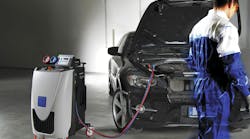Even the casual observer knows that the Middle East is one of the fastest growing markets for automotive products. In fact, Gulf Business reported that in 2013 research firm Frost and Sullivan predicted a 13 percent market growth between 2013 and 2017.
The growth, Gulf Business says, is driven by the propensity of vehicle owners keeping their vehicles longer, which inevitably leads to the need to replace broken and worn parts.
But with growth comes challenges, none of which will be more challenging than the parts distribution process. If you have any doubt about that, just look at the U.S. distribution model, which is still struggling with efficiency after decades of operation. It’s an easy trap to fall into.
The origin of this supply chain debacle was driven by many things, but perhaps the most important one was the decision for suppliers to push as much product through the chain regardless of the consequences as long as the distributors could tout ubiquitous parts coverage. Thus, the industry slogan — “The right parts at the right place at the right time” — was born.
No doubt that more parts — a flood of parts — has kept American motorists rolling. But with distributors having parts coverage for virtually every repair incident imaginable means that distributors are carrying parts that will never be sold. Any part that sits on the shelf costs money, and the longer it sits, the more money it costs. For the more efficient distributors that know their inventory, they eventually will return parts to their suppliers for partial credit. For less efficient distributors, they wind up eating the entire cost. As for the suppliers, the pinnacle of inefficiency is having to handle and provide credit on a returned part. In essence, this is an inefficient system created the day an unneeded part is manufactured.
| Aftermarket Business News on Youtube | |
|
You read the articles, now get more from Aftermarket BUsiness News by subscribing to our Youtube page. |
|
Just as bad is that the industry’s bloated inventory is slowing its growth. Although the industry grew steadily and, at times robustly, the inventory problem was always lurking in the shadows. As long as most players were making money and healthy margins, the unneeded, unsold inventory was tolerated and rationalized by claims of competitive differentiation. In reality, parts resellers were becoming more like one another and unnecessarily carrying bigger and bigger inventories just because their competitors were doing it. With everyone having the same big inventories, margins were driven down as the returns went up.
The good news for the U.S. distribution system is that a fair number of suppliers and distributors are now acting more like partners who are in this together, rather than operating as separate entities for their own individual good. Apparently, it has sunken in that competitiveness is actually enhanced for those who have adopted the partnership philosophy. And partnership is manifested in inventory transparency, that is, when both suppliers and distributors are able to see where parts are at any point in the supply chain.
As a result, needed adjustments can be made instantaneously instead of letting parts run their course only to be returned at some unspecified time. In effect, visibility — up and down the supply chain — enables suppliers and distributors to deal with stocking issues, pricing strategies, and underperforming product lines which, of course, keeps inventory in check and profit margins maximized.
Progressive suppliers and distributors, in many respects, are looking more like the big-box retailers that use transparent transactional data to account for the manufacture, flow and sale of products, as well as returns. The only distribution secrets held are what the suppliers are doing with other distributors. It’s the best of both worlds — supply chain efficiency is enhanced and proprietary relationships are guarded.
The U.S. aftermarket was once fast growing. Now the Middle East aftermarket is fast growing. Those who will do best in the Middle East will be those who examine the past mistakes made by the U.S. aftermarket…and are fast learning.
Subscribe to Aftermarket Business World and receive articles like this every month….absolutely free. Click here.



